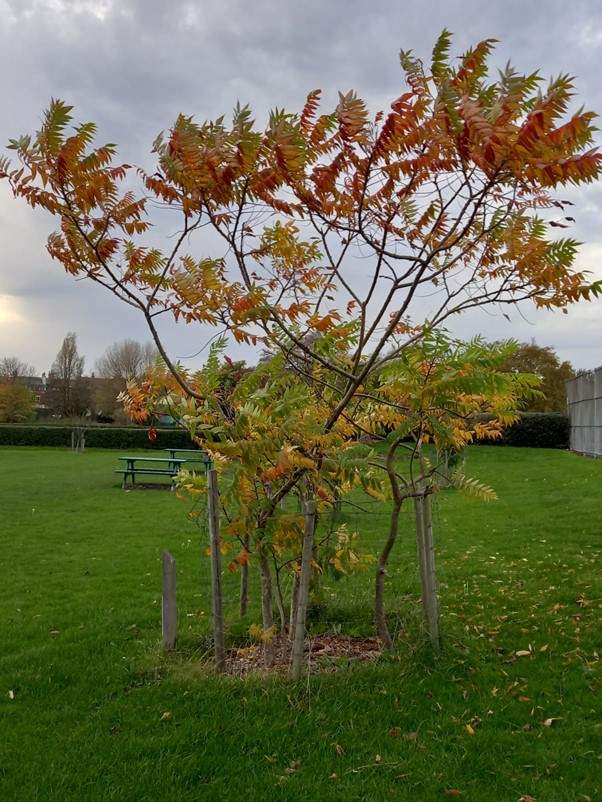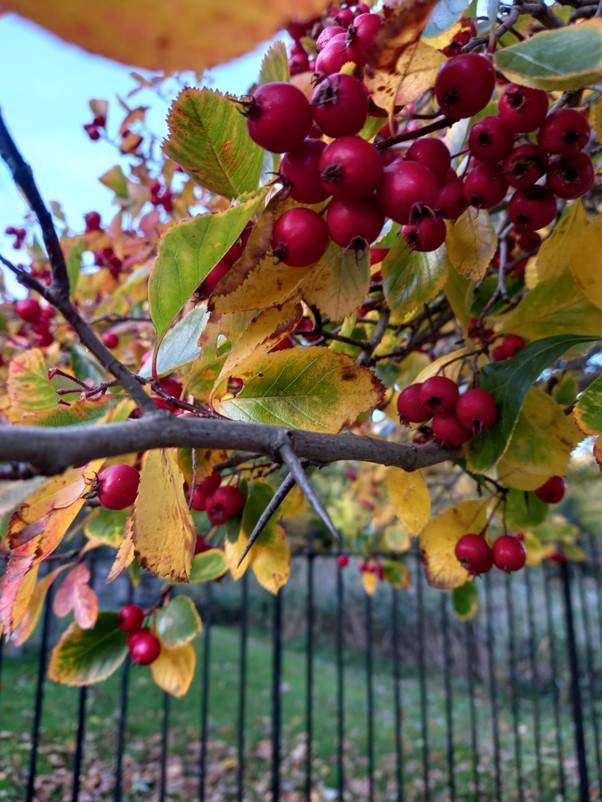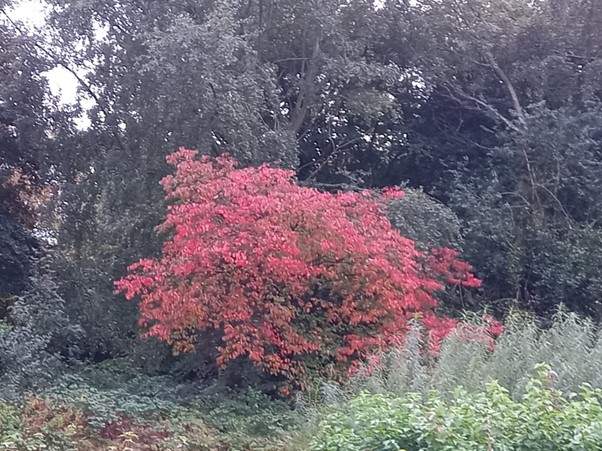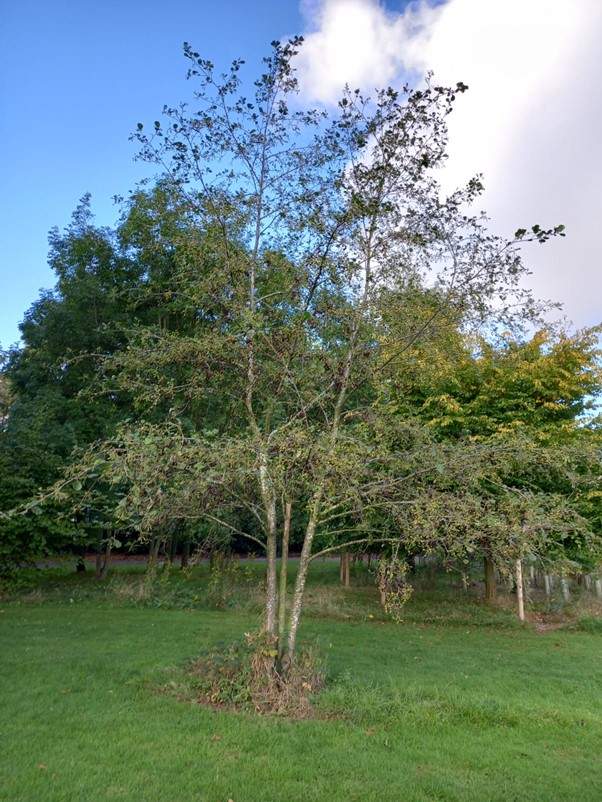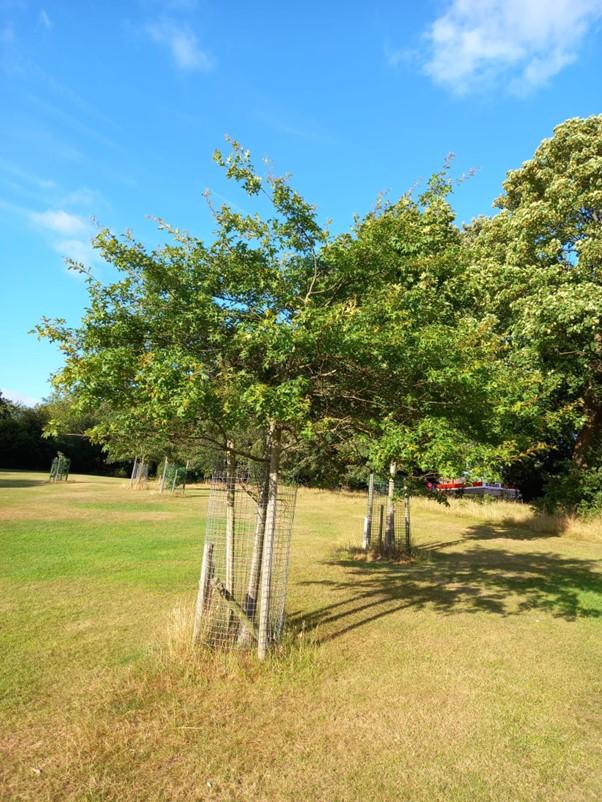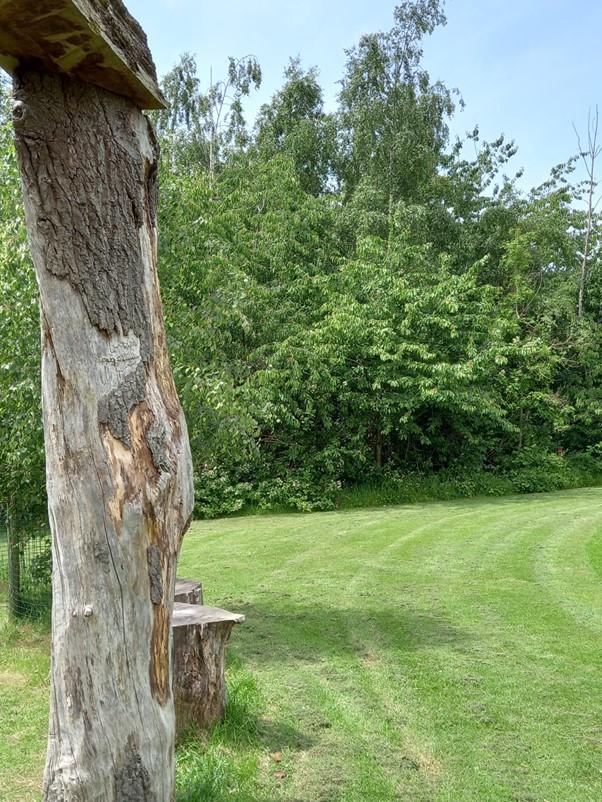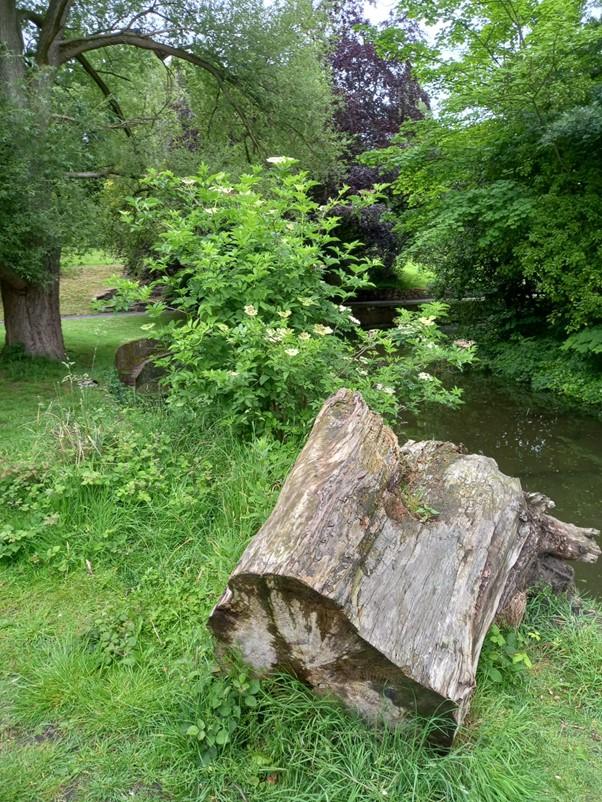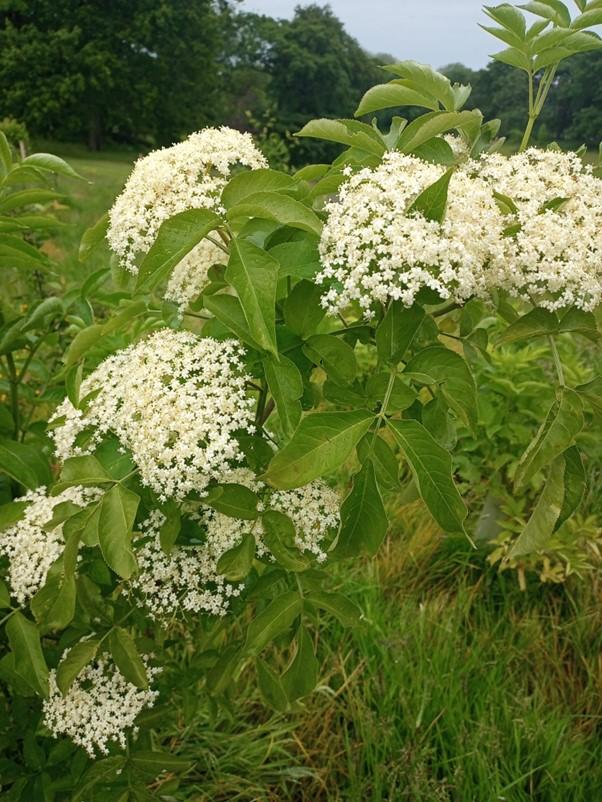Park trees of the moment
Cotoneaster ‘Cornubia’ 15/11/2022
Red and green: a delight to be seen
Cotoneaster ‘Cornubia’ (Tree Cotoneaster)
Most cotoneasters, and there are 70 species and 300 varieties, are small evergreen shrubby plants with showy red berries. But the two varieties in Princes Park (C. ‘Cornubia’ tree no. 219 and C. x watereri tree no. 613) are trees growing to five to six metres that this year are heavily laden with fruit. They look edible, but beware, they can be toxic and cause stomach upsets.
They are members of the rose family and are closely related to hawthorn, rowan and pyracantha. Their creamy coloured bunches of flowers in June are a valuable nectar source for bees and other insects when nectar is generally scarce, and the profusion of red berries provide a late winter feast for thrushes and blackbirds.
The name cotoneaster comes from the Latin ‘cotone’ meaning quince, and ‘aster’ meaning resembling.
In the wild, cotoneasters grow in Asia, North Africa and Eastern Europe, but our two trees are hybrids bred here in the UK. Lionel de Rothschild who described himself as a ‘banker by hobby but a gardener by profession’ hybridised C. ‘Cornubia’ at his Exbury estate in Hampshire in 1933, and John Waterer hybridised C. x watereri at his Surrey nursery. So, in a sense both our trees could be described as being native to the UK!
This is the last Tree of The Moment for a while. Dany, who takes the photos, and Dave who writes the texts, are off to the sunnier climes of Tasmania for a few months, where we will enjoy being in the company of some of the 750 species of eucalyptus that grow in Australia. And of course, there is all the endemic flora of Tasmania; Southern Beech (Nothofagus cunninghamii); Leatherwood (Eucryphia) that feeds the native honeybees, and the Huon Pine that gives a honey-coloured wood prized by colonial boatbuilders, who almost wiped it out. Like the extinct Tasmanian tiger and emu. Lots of trees there to protect, in the virgin temperate rainforest, threatened by logging and mining. Have a look for our Nothofagus tree no. 409 on the Roly Poly, and our two Eucryphias ‘Nymansay’ nos. 206 and 209 near the magnolias.
Tree no. 218, 219 & 613 – planted in 2015
Mount Fuji Cherry (Prunus ‘Shirotae’) 12/11/2022
An increasingly enchanting walk
The Cherry Walk
Mount Fuji Cherry (Japanese Flowering Cherry) (Prunus ‘Shirotae’)
This is the old Japanese cultivar of the wild flowering Cherry tree, which was only introduced to the UK in 1905. It has the typical Japanese flat-topped form. It is a vigorous cultivar that may make a complete arch over the winding footpath.
We have to thank Jean Grant (the first chair of Friends of Princes Park) for the cherry walk. About 15 years ago, when several of the original trees had died, Jean made an impassioned plea to reinstate the cherry walk to the FoPP tree group, who were planting the native copses at the time. Shirotae was chosen for its prolific white flowers. Subsequently FoPP member Christine Ruth organised the planting of white narcissus in the grassy margins of the path. Each year as the trees grow bigger, flowering becomes more delightful, and this year the autumn colour is stunning too.
Mount Fuji is the holy mountain in Japan covered with eternal snow that is reflected in the shape of Shirotae when in full flower. The word shirotae means a fine white cloth made from the soft bark of the Paper Mulberry.
Since around 700AD, people in Japan, have sat down to lunch washed down with Saki under cherry blossoms (Sakura trees), a national ritual started by the Imperial Court.
Records of cherry flowering times in Kyoto have been kept for 1,200 years, and show them to be relatively stable from 812 to the 1800s, but full bloom times became earlier after that. Peak of flowering in the 1850s was on average April 17th, by 2020s it was April 5th.
Staghorn Sumac (Rhus typhina) 06/11/2022
Staghorn Sumac (Rhus typhina)
The name staghorn came from Carl Linnaeus’s Latin description ‘Ramis hirtis uti typhi cervini’ meaning ‘the branches are rough like antlers in velvet’. In winter when the brightly coloured leaves (red, yellow and orange) have fallen, the stiff angular branches resemble young deer antlers covered in soft brown fur.
Although members of the Rhus genus are found widely in America, in parts of China and in Africa, the Staghorn Sumac only grows in the wild primarily in south-eastern Canada and the Appalachian Mountains.
Traditionally the flowers of Sumac have been soaked and strained in cold water, sweetened and made into pink ‘lemonade’ sometimes called ‘Indian lemonade’. Some beekeepers use the dried flowers as a source of fuel for their bee calming smokers.
It may be some years before our Sumac comes into flower.
Tree no. 612 – planted in 2017
Autumn Flowering Cherry (Prunus subhirtella ‘Autumnalis’) 02/11/2022
Early flowers? Or late leaves?
Autumn Flowering Cherry (or Winter) (Prunus subhirtella ‘Autumnalis’)
In most years the leaves of Autumn Flowering Cherry fall in a flurry of gold and orange during October. Then in November, on bare branches, tiny white or pink flowers appear scattered along the spindly twigs.
This mild and warm year, even before the leaves have turned into their autumn colours, the tree is in full flower. It should continue to flower until March.
This Japanese cultivar, that was introduced into UK at the start of the twentieth century, is a hybrid unknown in the wild.
There are over 400 species of Prunus, many of them producing edible fruit such as peach, nectarine, plum, apricot and almond. The soft juicy fruit covers a hard shell called the stone or pit, which itself encloses a seed or kernel. In some species the kernel is edible (almond) in others (apricot) they contain poisonous cyanide. Birds eat the small dark cherries that develop on P. s. ‘Autumnalis’ in the summer after flowering.
And the name? - subhirtella translates as ‘somewhat hairy’.
Tree no. 310 – planted in 2013
American & Variegated Sweetgum (Liquidambar styraciflua & ‘Variegata’) 22/10/2022
A tale of two trees
American (tree no. 308) & Variegated (tree no. 314) Sweetgum (Liquidamber styraciflua & ‘Variegata’)
American Sweetgum has the most brilliant autumn colours of purple, red, marmalade orange and yellow making it one of the most popular ornamental garden and parkland trees.
Introduced here in 1860s after its discovery in Central America by a Spanish naturalist who described it as a large tree producing fragrant gum resembling liquid amber - and the name stuck. The five-pointed leaves can easily be confused with maple leaves which have a similar shape (like the Canadian flag symbol), but Liquidamber leaves grow alternately along the stems, whereas maple leaves are always in opposite pairs.
Liquidamber is an important commercial forestry tree in Southeastern United States. The wood is reddish brown and may have black grain in the heartwood, and takes a beautiful satiny polish. In the timber trade, the heavy straight grained wood is known as satin walnut, hence is used for furniture making. The gum is used medicinally and to make chewing gum.
Our other variety of Sweetgum, ‘Variegata’ (growing near the southwest corner of the lake) has bright green and pale cream leaves which also colour up at this time of the year. In the Spring, there is the added bonus that the leaves emerge with a delicate pink flush.
Tree nos. 308 & 314 – planted in 2013
Broadleaved Cockspur Thorn (Crataegus persimilis) 18/10/2022
A newish species with many forms
Broadleaved cockspur thorn (Crataegus persimilis)
This widely cultivated tree, so common in the UK which hails from southern Ontario in Canada, and a few American states, is thought to be a recent naturally occurring hybrid of the species Crataegus succulenta and Crataegus crus-galli. C. succulenta (Fleshy hawthorn) has attractive fleshy round berries, while C. crus-galli (Cockspur thorn) has less showy berries but huge thorns up to 8cm long. Our Broadleaved Cockspur Thorn has more modest thorns 3-4cm long that can still inflict a nasty scratch and could certainly discourage a grazing animal from having an otherwise tasty meal.
As is often the case with hybrids there is a lot of variation in C. persimilis - in leaf size, leaf shape, flower structure, and size and shape of tree. This one near the boat house has grown into an almost perfect dome shape and this year has a huge crop of berries which the birds are less keen to eat until food is scarce in the winter. For us humans the fruit, although tasty, may cause mild digestive upsets.
Tree no. 229 – planted in 2013
Silver Birch (Betula pendula) 07/10/2022
Silver Birch (Also known as Pendulous Birch) (Betula pendula).
The remains of this birch, standing near the tennis courts is heavily populated with fruiting bodies of the birch polypore (Fomitopsis betulina).
Probably, 10 or 20 or more years ago, the tree was infected with spores landing on exposed wood - a broken branch or damaged bark - which slowly colonised the tissues of the tree with mycelium (the main body of the fungus) reducing the trees vigour until it died maybe four or five years ago. Over that long period of decline, woody tissues were reduced to a soft pulp, leaving few nutrients for the fungus to feed on.
At that point, the fungus, sensing a loss of food supply, moved quickly into its reproductive phase growing all those spectacular fruiting bodies which in turn will shed spores into the air, completing the cycle to infect another birch tree host.
Humans have a long history of association with the birch polypore going back thousands of years. The 5,300-year-old body of a herder found buried in ice high in the Alps was perfectly preserved. He was carrying two mushrooms on a leather thong - birch polypore and tinder polypore. Birch polypore is said to be a great treatment for intestinal worms particularly for the Whipworm, which was found preserved inside the herder.
Many other medicinal uses for the fungus have been suggested by Wild Food UK, and in the days when cut-throat razors were common, dried strips were used to hone the razor cutting edge.
Tree nos. 512, 513, 514 & 515 – planted in 2016
Sargents Cherry (Prunus sargentii) 30/09/2022
Sargents Cherry
first again with autumn colour
Sargents Cherry (Also known as Japanese Hill Cherry) (Prunus sargentii)
Charles Sprague Sargent discovered this species in the mountains of Northern Japan at the turn of the twentieth century. It is usually the first significant tree in most collections and parks to colour up at this time of year. It has been described as the 'creme de la creme' of ornamental cherries for its profuse spring pink flowers, its coppery first flush of leaves and of course it's brilliant autumn shades.
Sargent has a number of species of tree named in his honour - we have a Sorbus sargentiana growing on the east side of the lake, a Chinese tree, that will also have good autumn colour in the coming days.
Sargent was a famous American dendrologist who was instrumental in the development of American National Parks, and argued tirelessly for their protection against those who thought native forests should be harvested.
The tree can be seen from near the start of the cherry walk.
Tree nos. 606, 622 & 623 – planted in 2017
Common Alder (Alnus glutinosa) 27/09/2022
Autumn is here, but Alder trees are thinking of Spring
Common Alder (Also known as Black Alder) (Alnus glutinosa)
ext Spring our alder trees will be festooned with long slim male yellow catkins that will shed pollen into the wind to pollinate the short rounded green female flowers. Those immature catkins and flowers are already there on the trees, waiting through winter for the months to roll by for warmer weather to arrive.
Alder belongs to the birch family, and a striking difference between birch and alder is that birch has long tassel-like female flowers that shed in the wind, whereas female alder flowers are woody-like black conifer cones that stay firmly closed until they open in dry weather to let the seeds fall out.
Alder prefers to grow in damp, wet places and along river banks where their seeds can fall on moist soil, and germinate within a day or two.
The wood of alder has traditionally been used to make clogs and charcoal for gun powder. Because it resists decay in wet conditions, the foundation pilings for the city of Venice were made of alder wood.
This year the leaves of alders have been infested by the metallic-blue coloured Alder Beetle, thought to have been extinct between 1946 and 2003. But it was noticed in Manchester in 2004, and has spread widely over the North West and North Wales. Although the beetle nibbles away at the leaves making them very lacy and unsightly, the tree itself is hardly impaired, and will make new fresh leaves in Spring.
This tree is near the solstice oak.
Turkey Oak (Quercus cerris) 17/09/2022
Fast and
Loose: the life style of Turkey Oak
Turkey Oak (also known as Mossy Oak) (Quercus cerris)
Turkey Oak, the commonest oak in Princes Park, isn't fussy about which other oaks it mates with, so its leaf forms are often difficult to identify. It is also very fast growing and pushy, outpacing our native oaks.
Until about 15 years ago when FoPP volunteers started planting them, there were no native oaks in the park (except for the evergreen Holm Oak, and that probably isn't native on the mainland, only in Southern Ireland).
Squirrels have put a lot of effort into burying acorns in areas of long grass, to eat later, (and then forgetting about them) so we are now inundated with hundreds of unwanted Turkey Oak seedlings in most areas of the park.
Turkey Oak was introduced to UK in the early 1700's and with it came a parasitic wasp that feeds on the trees' flowers; the next year in the second half of the wasps' lifecycle it lives in the emerging acorns of the native oaks causing a distortion called knopper gall which effectively destroys the acorn. The knopper gall destroys so many native acorns that foresters in the New Forest in Southern England (famous for its oak woodlands) are so concerned about the demise of their oaks that they have decided to eliminate the invasive oaks.
Our own native oaks are still too young to produce acorns, so when they do it will be interesting to see how they get along with the parasitic wasps.
Tree no. 707
Common Whitebeam (Sorbus aria) 09/09/2022
Not very
common: the Common Whitebeam.
Common Whitebeam (also known as Beam Tree and Chess Apple) (Sorbus aria).
The Common
Whitebeam is rarely found in the wild and only on chalk or limestone in the
south of England, but as it is a medium sized tree (up to 12m) is often a
favourite for planting in parks and gardens. The closely related Bristol
Whitebeam is one of the UK’s rarest native trees found only on the cliffs of
the Avon Gorge.
The
Whitebeams are part of the large sorbus genus that includes Mountain Ash or
Rowan, the Service Tree and the True Service Tree.
In May it has clusters of insect-pollinated white flowers followed by red haw-like berries that can be made into a conserve - best when they are partly rotted after a frost. The leaves are green on top and felted white underneath (hence the name) transforming the appearance of the tree in strong winds, as noted by the poet Meredith 'Flashing as in gusts the sudden lighted whitebeam'. It is also described as 'Wind-beat whitebeam!' in Gerard Manley Hopkins' poem 'The Starlight Night'.
The young tree in the photo is growing on the south side of copse F, planted in 2011.
Edible as a conserve - Whitebeam berries
Blue Atlas Cedar (Cedrus atlantica glauca) 05/09/2022
An
endangered species from the Atlas Mountains.
Blue Atlas Cedar (Cedrus atlantica glauca).
A combination of human exploitation, pests and decreasing precipitation have caused a heavy decline of natural populations in Algeria and Morocco over the last 50 years. In 1966 there were 23,000 hectares in Algeria, today there are only 15,000 hectares.
Its timber is strong and durable and valued for joinery and furniture. Oil obtained from the tree's branches and leaves is antiseptic and used for treating skin diseases, cystitis and bronchitis, for insect repellents and in perfume.
In the wild it grows at 1,300-2,200m above sea level, and is able to survive spring and summer with little or no rainfall, existing on melting snow from the mountain peaks. In the Mediterranean it is used for afforestation of barren lands.
Why is it tree of the moment? Our four young trees (two at the Sunburst Gates and two above the Cherry Walk) are making female cones - I think - for the first time. No signs of the male cones yet, but there is still time because they pollinate in October.
I wonder if anyone has thought of growing them as a lowland timber crop? That might save the wild population.
Tree nos. 101, 102, 111 & 114 – planted in 2013
Medlar (Mespilus germanica) 28/08/2022
A tasty
morsel with bawdy associations!
Medlar (Mespilus germanica) growing near Park Nook flats.
A small tree or large shrub in the rose family (as are apples, pears and hawthorn). The fruits are best eaten bletted, that is after frost has caused them to rot and shrivel until the astringent tannins have gone. Sounds revolting, but they have a rich flavour and a texture like apple sauce.
Medlar has been in cultivation for at least 3,000 years and was introduced to Greece around 700BC and to Rome 200BC. In UK it was important in Roman and Medieval times but by 17th century was superseded by other fruit, and is now rather rare in gardens and parks.
In the 16th and 17th centuries medlars were bawdily called 'open arses' because of the shape of the fruits, inspiring boisterous and humorously indecent poems in many Elizabethan and Jacobean plays. Shakespeare referred to the rottenness of medlars in several plays, and in Romeo and Juliet he writes of Romeo's love for Rosaline:
Now will he sit under a medlar tree,
And wish his mistress were that kind of fruit, O Romeo, that she were, O that she were, An open-arse, and thou a pop'rin pear. What they got away with in those days! It is all in the eye of the beholder! Medlar fruits
Sycamore (Acer pseudoplatanus) 21/08/2022
A successful immigrant, now much
maligned.
Sycamore (Plane in Scotland) (Acer pseudoplatanus).
Now one of the commonest trees in the UK, the Sycamore didn't exist here before about 1500 during Tudor times. By 1800 it had escaped from aristocrats landscaped gardens to firmly establish itself in the countryside.
Gardeners complain about all the seedlings they have to pull up, and foresters say it elbows out slower growing native trees, car owners say it drips sticky honeydew on their shiny vehicles, homeowners complain they shade their windows from the sun and commuters are delayed because of that old excuse 'leaves on the line'.
So, what are these Johnny Come Lately trees good for? Sycamore is now firmly established in natural ecology. It grows masses of nectar-rich flowers in May feeding bees and other insects, and hosts hordes of aphids - a spring and summer larder for small birds. The pale honey coloured wood is used to make musical instruments, kitchen equipment, butchers blocks and is highly sought after for fine cabinet making.
Finely polished, the wood takes on a three-dimensional visual quality not seen in other timbers. And if size is important, there are countless huge splendid specimens growing all over the country.
Not all bad then!
Oh, and Pharaoh Tutankhamen's tomb contained furniture made from Sycamore. So, conjecture has it, that when Egypt was a green and lush land Sycamore must have grown there too.
Incense Cedar (Calocedrus decurrans) 13/08/2022
500 years
of flowering: year one.
Incense Cedar (Calocedrus decurrans)
Our Incense Cedar is about 10 years old, and is probably flowering for the first time. (Strictly speaking it is making male and female cones, not flowers). It could go on doing this year in year out for 500 years. A quick estimate says there are 250 cones on the tree this year. Each cone contains two seeds, that's 500 seeds this year. Assuming the tree grows a conservative 25 per cent per year that would be 625 seeds next year. By the time it is mature in 250 years that would be a lot of seeds. Those of you who want to know how many can work it out themselves!
In its Californian home it can grow to 60m, here to a more modest 40m, but equal to a thirteen-storey block of flats. In the wild its numbers are declining due to over-enthusiastic logging. Its timber is aromatic and prized for cabinet making.
Its name comes from the Greek 'kalo' - beautiful, and 'cedrus' - like Cedar. 'Decurrans' means hanging down, to describe the branch formation of mature trees. The common name 'incense' probably refers to the aroma of its freshly crushed leaves. It is a member of the cypress family.
Tree no. 103 – planted in 2013
Nymans Eucryphia (Eucryphia x nymansensis) 05/08/2022
Surprise
flowers from Chile.
Nymans Eucryphia (Eucryphia x nymansensis) tree no. 206.
Maybe it was the hot summer that did it, but seeing the first flowers (with a bumble bee taking its fill) on our very young Eucryphia sapling was quite a surprise today. I was expecting to have to wait many years for flowering to happen!
There are seven species of eucryphia, two from Chile and five from Australia with over 50 hybrid varieties. One Tasmanian species, commonly known as Leatherwood is famous for its delicious rain-forest produced honey.
Our Nymans Eucryphia is a hybrid of the two Chilean species E. cordifolia and E. glutinosa crossed at Nymans (now a National Trust Garden in Sussex) in 1914. When full grown it may reach 23m, as a narrow spire, and will be a glorious sight in summer when covered in flowers.
Chile and Australia have been separated for 45 million years and the presence of closely related species in such widely separated continents is a reminder of the phenomenon of continental drift. These splendid flowers have survived the genetic test of time, and now they are growing here in Princes Park near our magnolia grove. Hurrah!
Tree nos. 206 & 209 – planted in 2021
Pin Oak (Quercus palustris) 31/07/2022
A
festival, and new growths on our oaks.
Pin Oak (Quercus palustris).
April 1st is the day of Lammas, a pagan festival adopted by Christians to celebrate the first cereal harvest of the year. It coincides with a strange burst of new leaves on oak and beech trees called Lammas growth, particularly noticeable on our American Pin Oak (no. 415), and this year to a lesser extent on our young English Oak saplings.
Traditionally throughout Europe the first sheaf of corn would be cut at dawn, winnowed, ground into flour and baked into a loaf to share at the Lammas Mass, in recognition of the end of a growing season and to celebrate the bread of life.
In the weeks before harvest people were at their highest risk of starvation as stocks from the previous harvest came close to being depleted. New stocks gave reason for the community to be grateful and to celebrate with dance and cheer.
Lammas growth on oak trees is a trick evolved to cope with insect or fungal damage on earlier spring foliage that could leave trees short of essential sugars to store over winter, ready to start the following spring flush.
People and trees both need a good Lammas harvest to see them through.
Tree no. 415 – planted in 2013
Honey Locust (Gleditsia triacanthos) 21/07/2022
More than
a mouthful for a woolly mammoth
Honey Locust (Gleditsia triacanthos)
This bright yellow leaved thornless cultivar of the Honey locust of North America glows in morning sunshine.
Its parent, green leaved and extremely thorny (hence triacanthos meaning three thorns together) evolved during the last Ice Age 2.6million years to 11,000 years ago, when its sweet palatable seed pods 'honey locust' are thought to have been eaten by woolly mammoths and other herbivorous mega fauna and distributed as undigested seeds in a pile of highly fertile mammoth poo.
The widely spaced groups of thorns prevented these huge beasts from eating the foliage, so they could only eat the fallen tasty nutritious seed pods off the ground.
Smaller modern herbivores such as deer and goats are undeterred and can nibble between the thorns on trees that have not had time to evolve with more closely spaced thorns.
Not much of a mouthful for them!
Tree no. 313 – planted 2013
Mountain Ash (Sorbus aucuparia) 16/07/2022
Surely
it's not Autumn already.
Mountain Ash (from the original Latin name Montana fraxinus used before Linnaeus; also known as Rowan from the Viking word meaning red) (Sorbus aucuparia).
This is a particularly upright form, probably the variety Sheerwater seedling, favoured for roadside planting.
Mountain ash is a short-lived (about 80yrs) tree from the uplands of Europe and Britain where it survives at the height of the tree line above which only hardy grasses and heather survive.
In Scotland and Ireland, it was often the rural homestead tree, planted near the front door to keep witches and evil spirits away. In more modern times with the popularity of domestic gardening this easy to grow tree that tolerates most soil types has become synonymous with urban Britain.
The regular crops of heavy berries are palatable after cooking to make jellies and conserves - if there are any left after the thrushes and blackbirds have gorged themselves, often stripping a tree in a single day.
I am surprised every year to see heavy crops of berries that I associate with Autumn so early in the summer. Surely, we don't need winter woollies yet!
Tree no. 231 – planted in 213
Horse Chestnut (Aesculus hippocastanum) 11/07/2022
Oh no!
Moths are eating the chestnut leaves again!!
Horse Chestnut (Also known as Conker Tree) (Aesculus hippocastanum)
This much-loved tree, so popular with boys in Britain for their conker battle games, originally grew in a small mountainous area of south-east Europe. It has become an iconic tree of urban and parkland Britain with its sticky winter buds and showy tall spring candle like flowers. It was even immortalised in Longfellow’s poem ‘The Village Blacksmith’ with the famous opening line 'Under the spreading chestnut tree the village Smithy stands...’
In 1984 a very small (5mm long!) moth was found to be infecting horse chestnut trees in Yugoslavia. Two years later the moth was declared a new species of Cameraria. It only took 18 years to reach Britain (40 miles per year), and now most trees are affected by the moth's little caterpillars eating away at the leaves.
Three trees near donkey Judy's grave are looking very moth eaten and sad.
There are no effective control methods available to deal with the little pest at present, but hopefully a predator that enjoys eating Cameraria moths will turn up soon and keep their numbers down to an acceptable number so that we can enjoy the splendour of the chestnut once again.
Oriental Plane (Platanus orientalis) 01/07/2022
Shade for
Hippocrates and his students.
Oriental Plane (Platanus orientalis) - not to be confused with the widely planted London Plane.
A delightfully proportioned dwarf form of Oriental Plane growing on a bank at the south end of the lake is Princes Park's version of the huge Oriental Planes that grow from Mediteranean Greece eastwards as far as Iran and Northern India.
Hippocrates (460-370BC) taught his students in the shade of an enormous Oriental Plane. A 500-year-old descendant of that tree growing on the same site on the Island of Kos is a living monument to the 'Father of Medicine'.
All the Oriental Plane trees growing west of Greece are introduced, and Pliny's 'Natural History' describes their westward progress 'introduced among us from a foreign clime for nothing but it's shade'. Pliny (23/24-79AD) details 25 remedies using preparations from the bark and leaves for burns, bites, stings, frostbite and infections.
A tree believed to have been planted at an Islamic shrine in Kashmir in 1374AD is believed to be the oldest Oriental Plane in the world.
Our tree is likely to be as old as Princes Park, so now clocking up a mere 180 years, but on sunny days doing its best to give us some welcome shade!
Weeping Beech (Fagus sylvatica ‘pendula’) 25/06/2022
Mystery of the
Weeping Beech
Weeping Beech (Fagus sylvatica 'pendula')
Mystery surrounds the origins of this most beautiful and dramatic of all weeping trees, a cultivar of the well-known Common Beech.
Wikipedia says it was found in an English Park by garden designer Louden in 1836. The Collins tree guide says it was sent from France to Knaphill Nursery in Surrey in 1926. Whichever is right, it is likely Paxton would have wanted one in our park.
Common Beech, long thought to be native to southern counties of England is now said to have been introduced by neolithic farmer/gatherers walking over the land bridge from continental Europe around 4,000BC before the Channel formed after the Ice Age. Beech seeds are known to have been part of these early settler’s diet. This introduction was around the same time that the neolithic community in this area built a burial chamber using sandstone, the remnants of which are now famously known as 'The Calderstones'. This was before Stonehenge and before the Egyptian Pyramids.
Every few years Beech trees produce vast quantities of mast (seed), probably dependant on good growing conditions the previous year, and also as a result of the trees building up energy since the last heavy crop. This year looks to be one of those good mast years. Our specimen near the lake is still too young to join in this bountiful production. What a feast for the squirrels!
Tree no. 213 –
planted in 2013
Small Leaved Lime (Tilla cordata) 21/06/2022
Soon be a feast for
the bees!
Small Leaved Lime (also known as Small Leaved Linden) (Tilia cordata). A tall tree growing at the north end of the lake.
A tree native to UK and most of Europe. Pollen deposits in peatland show that this species was dominant in lowland North-West England 5,000 years ago when the climate was warmer. Needs summer heat to ripen the seeds so has become rare in the wild in recent centuries. Maybe global heating will turn that round. Some giant coppice stools survive from prehistory, making them the oldest trees in Britain.
They can grow to 38m so our tree has the potential to become the tallest tree in the park.
It is just about to break into flower with a heavy sweet scent that bees find irresistible. 'Linden honey' is delicious, and limeflower tea has sleep inducing properties. The finely grained wood was favoured by the Dutch woodcarver Grinling Gibbons for altarpieces and was used for carvings in St Paul's Cathedral, Windsor Castle and Chatsworth.
Bird Cherry (Prunus avium) 15/06/2022
Quick, the birds are
eating all the cherries!
Bird Cherry (also known as Wild Cherry, Sweet Cherry and Gean) (Prunus avium).
A tree in the rose family, native to Norway and south through Europe as far as Morocco and the western Himalayas.
All parts of the tree are mildly poisonous except for the ripe fruit. Wild cherry stones have been found in Bronze Age settlements throughout Europe including Britain. As the main ancestor of the cultivated cherry, the wild species' genes are found in most of the world's cultivars of edible cherries.
The hard reddish/brown wood is valued for wood turning and cabinet making.
Blackbirds, thrushes and woodpigeons gorge themselves on the rather sour ripening fruit.
You can see a group of trees on the edge of the copse just north of Woodhenge. Be quick before the cherries are all gone!
Aleppo Pine (Pinus halepensis) 13/06/2022
Aleppo Pine (also known as Jerusalem Pine) (Pinus halepensis).
A tree from the hotter parts of the Mediterranean with outlying populations in Syria, Jordan, Israel and Palestine. Usually a low altitude tree, but in North Africa grows at 1,700m.
Resin taken from the trunk is used industrially and to flavour the Greek wine retsina. In Tunisia a pudding is made from the pine nuts and cream.
Aleppo pine is grown commercially on the edges of deserts. Paul Cezanne had one in his garden at Aix-en-Provence, which was the inspiration for his painting “The Big Trees”.
The photos, taken in June 2022, show one of our two trees in full pollination mode. See the female cones high up and the small male cones on lower branches.
Tree nos. 115 & 116 – planted in 2018
Elder (Sambucus Nigra) 06/06/2022
Elder (also known as
Elderberry, Black Elder, European Elder and Tramman - Isle of Man) (Sambucus
nigra). Native to most of Europe as far East as Turkey, and common in hedgerows
and scrubland. Rarely planted, although Princes Park has seen many planted in
the last few years. One older specimen (pictured) grows at the edge of the lake
near the Boat House.
The purple berries are mildly poisonous in their raw state as are unripe berries, the seeds and all green parts. However, both flowers and berries have a long tradition of culinary use, primarily for cordial, wine and champagne. In recent years commercial soft drink producers have used Elder for flavouring. Elder is also commonly used in dietary supplements and traditional medicine.
Indian Horse Chestnut (Aesculus indica) 31/05/2022
Indian Horse Chestnut (Aesculus indica) in Princes Park is growing on the north east side of the lake and was in full flower at the end of May. Indian Horse Chestnut is native to the Himalayas from Afghanistan and Pakistan to Western Nepal where it grows up to 3,000m. The 'conkers' are used in traditional medicine and also as food for humans during times of food shortage.
Tree no. 227 – planted in 2013




